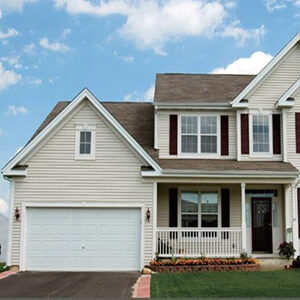
Fiber cement plank, including the wood-grain varieties, is highly resistant to moisture because its primary components are cement and sand, not organic wood fibers that swell and rot.
Here is a breakdown of how the plank resists moisture and the potential for water collection in the grooves.
Moisture Resistance Mechanism
Fiber cement plank is a composite material made from a dense mix of:
- Cement (Portland cement): This is the binder that provides the structural strength and water-resistant nature of the material. Cement does not rot or swell when exposed to water, unlike wood.
- Silica Sand: This adds stability and bulk, contributing to the density and hardness that prevents water absorption.
- Cellulose Fibers (Wood Pulp): These are added for flexibility to help resist cracking, but they are a small component reinforced by the cement matrix. The cement composition ensures the overall product does not absorb water like traditional wood siding.
- Water and Additives: Used to bind and cure the mixture, often through a high-pressure steam curing process, which results in a dense and stable board.
This unique, inorganic composition allows the plank to:
- Resist Rot and Swelling: It maintains its structural integrity and dimensional stability, even in wet or humid conditions, unlike wood.
- Deter Mold and Mildew: Its non-organic base does not provide a food source for mold and mildew growth.
- Shed Water: The material and its factory-applied protective coatings (if pre-finished) effectively shed rainwater.
Water Collection in Wood Grain Grooves
While fiber cement planks are highly moisture-resistant, the wood grain texture on the surface is a factor to consider:
- General Performance: The planks are designed to shed water, and the embossed wood grain texture itself is unlikely to trap standing water under normal, vertical installation, as gravity will draw the water down and off the surface.
- Potential for Issues: However, any texture, including deep wood-grain grooves, can potentially hold dirt, dust, and debris. If debris accumulates in the grooves, it can trap moisture against the surface.
- Installation is Key: Even though the material resists rot, moisture can be absorbed through exposed, unsealed cut edges or where the siding comes into prolonged, direct contact with standing water (e.g., near decks or roofing). Proper installation, including following clearance guidelines, sealing cut edges with paint or caulk, and ensuring a moisture barrier behind the planks, is critical for long-term performance and preventing water-related issues like peeling paint or localized swelling.
In summary, the material’s cement-based core provides the moisture resistance, preventing the rot and swelling seen in natural wood. The grooves themselves should not collect water if the siding is installed correctly and maintained with routine cleaning.
OCT
2025
